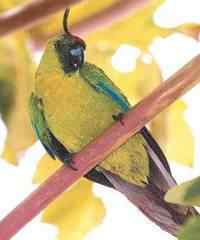预告2009年红色名录:非洲其中一个焦点
还未正式发表,要等到下月14日,先报道一下非洲的Sidamo Lark。
好像股市楼价,有起有落,今年会有几种提高了受胁级别,也有些会降级。
The Red List 2009 is coming and Africa is in the spotlight.
14-04-2009
On May 14 BirdLife International will release the 2009 Red List update for birds. BirdLife is the official IUCN Red List Authority for birds and this year will see a number of species being uplisted – meaning their situation is getting worse.
The 2009 update highlights the plight of Sidamo Lark Heteromirafra sidamoensis. Found only in south-central Ethiopia, its global range was previously estimated at 760 km2 with a population size of almost 2,000 individuals. But studies in 2007-2008 by researchers from BirdLife, the University of Cambridge, Ethiopian Wildlife and Natural History Society (BirdLife in Ethiopia) and University of East Anglia discovered that available habitat covered just 35 km2, and density estimates provided a global population estimate of only 90-256 adults, all found on the Liben plain. This new information – recently published as a paper in the journal Animal Conservation – means that Sidamo Lark is being uplisted to Critically Endangered – the highest level of threat – in the 2009 Red List update. If it were to go to extinct, it would have the dubious honour of being the first known bird extinction for mainland Africa.
The lark is adapted to Ethiopia's "rangeland" – the savanna of native grasses that traditionally covered large parts of east Africa, but is now rapidly disappearing. In areas where the Liben plain has been overgrown by bush, converted into farmland or destroyed by overgrazing, the team rarely found Sidamo Larks. If the rangeland goes, so will the lark.
Rangeland degradation is often overlooked by conservationists, but it is not just the birds that suffer from the change in land use. The native people, the Borana pastoralists, also rely on intact rangeland to support their nomadic lifestyle. The degradation of the Liben Plain results directly from the Borana losing the use of their traditional rangelands. This has disrupted the subtle and sustainable seasonal movements of livestock which previously allowed grassland to be maintained in good condition.
"If the situation doesn't improve soon, this species could disappear in as little as four years" —Kiragu Mwangi, BirdLife International
"If the situation doesn't improve soon, this species could disappear in as little as four years", says Kiragu Mwangi, one of BirdLife's team members.
Sidamo Lark seems to be dependent on grassland 5 to 15 centimetres tall. Away from the Liben plain, there is no similar vegetation for over 200 km, meaning the lark has nowhere else to go.
"It's effectively like living on an island, and that's where most extinctions happen", says Dr Claire Spottiswoode, from the University of Cambridge and lead author of the paper.
Africa may have been spared bird extinctions so far because there are still relatively few such severely fragmented habitats. However, rangelands are now being lost far beyond the Liben plain.
This May, the researchers are planning to revisit the Liben plain to discuss conservation plans with the local communities. The team is hopeful that support will be forthcoming, because many of the local pastoralists would prefer to revive their traditional lifestyle. This work will be funded by the BirdLife Preventing Extinctions Programme.













发表评论:
◎欢迎参与讨论,请在这里发表您的提问或看法,交流您的观点。